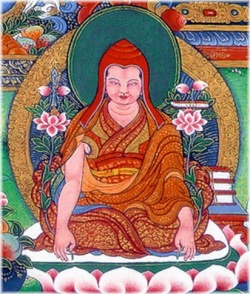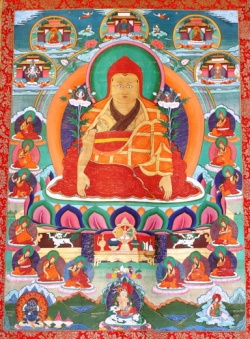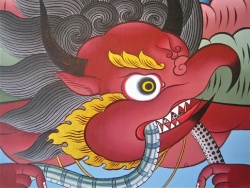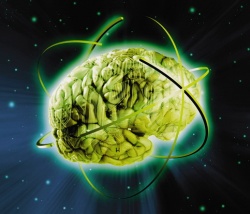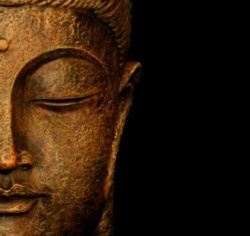Dolpopa Sherab Gyaltsen
Dolpopa Sherab Gyaltsen (Dol-po-pa Shes-rab Rgyal-mtshan 1292-1361),
was one of the most important and original thinkers in Tibetan history, and perhaps the greatest expert on the tantric teachings of the Kalacakra, or Wheel of Time.
"In the early 14th century, Dolpopa Sherab Gyaltsen (also written "Dolbuwa," 1292-1361) became the main figure of the Jonang.
After studying each of the existing Buddhist traditions in Tibet including the Sakya, Kagyu, and Nyingma, Dolpopa settled in Jomonang.
Dolpopa then served as the abbot of Jonang Monastery and in the year 1333 completed the Great Stupa of Jonang.
Tibetan Buddhist master Dolpopa Sherab Gyaltsen known simply as Dolpopa, the Tibetan Buddhist master known as The Buddha from Dolpo, is often seen as the founder of the Jonangpa tradition of Tibetan Buddhism.
However, the doctrinal origins of the Jonangpa tradition in Tibet can be traced to early 12th century master Yumo Mikyo Dorje, but they became much wider known with the help of Dolpopa Sherab Gyaltsen.
He was born in the Dolpo region of modern Nepal but in 1309, when he was seventeen, he ran away from home to seek Buddhist teachings, first in Mustang, and then in Tibet.
Dolpopa became one of the most influential and controversial of Tibetan teachers.
Originally a monk of the Sakya order, he developed the teaching on emptiness view known as Shentong (gzhan song), which is tied to the Tathagatagarbha tradition and the Indian Yogacara school.
He is considered to be one of the greatest exponents of the Kalachakra or Wheel of Time and a consummate practitioner of the Six Yogas:
Dolpopa was a practitioner of the Six-branch Yoga, the perfection stage practices of the Kalacakra Tantra, and although he based his doctrinal discussions upon scripture, in particular the Kalacakra related cycles, his own experience in meditation was crucial to the formulation of his theories.
Dolpopa Sherab Gyaltsen (Wylie: Dol-po-pa Shes-rab Rgyal-mtshan) (1292-1361), known simply as Dolpopa, the Tibetan Buddhist master known as "The Buddha from Dolpo," is often seen as the founder of the Jonangpa tradition of Tibetan Buddhism.
However, the doctrinal origins of the Jonangpa tradition in Tibet can be traced to early 12th century master Yumo Mikyo Dorje, but they became much wider known with the help of Dolpopa Sherab Gyaltsen.
Biography
He was born in the Dolpo region of modern Nepal but in 1309, when he was seventeen, he ran away from home to seek Buddhist teachings, first in Mustang, and then in Tibet.
Dolpopa became one of the most influential, original yet controversial of Tibetan teachers.
Originally a monk of the Sakya order, he developed a teaching known as Shentong or Zhentong (gzhan song), which is closely tied to the Indian Yogacara school and the Tathagatagarbha tradition.
He is considered to be one of the greatest exponents and practitioners of the Kalachakra or "Wheel of Time":
"It is important to keep in mind that Dolpopa was a consummate practitioner of the Six-branch Yoga, the perfection-stage practices of the Kālacakra tantra, and although he based his doctrinal discussions upon scripture, in particular the Kālacakra-related cycles, his own experience in meditation was crucial to the formulation of his theories."
In 1314, when he was twenty-two years old, Dolpopa received full monastic ordination from the famous abbot of Chölung Monastery, Sönam Trakpa (1273-1352), and made a vow at the time to never eat slaughtered meat again.
In 1321, Dolpopa visited the monastery of Jonang for the first time.
He then visited Tsurphu Monastery for the first time and had extensive discussions with Rangjung Dorje, the third Karmapa, about doctrinal issues.
It appears that Rangjung Dorje almost certainly influenced the development of some of Dolpopa's theories, possibly including his Shentong method.
Other than this, he had studied almost completely under the Sakya tradition until he was thirty years old in 1322, and he had taught for most of the previous decade at the great Sakya Monastery.
In 1327, after the death of his guru Yönden Gyantso, Dolpopa decided to fulfill a prayer he had made at the great stūpa at Trophu (Khro phu) to repay his master's kindness.
"He also felt that the stūpa would become an object of worship for people who were not fortunate enough to engage in study, contemplation, and meditation, and therefore provide them with the opportunity to accumulate virtue."
In 1329 a large stūpa was quickly built at upper Zangden (Bzang ldan), but it collapsed.
In 1330 the foundations for a much larger stūpa were laid at a new site in lower Zangden. It was a massive undertaking and involved many workers and artisans.
Support flowed in from around Tibet. It was finally consecrated in 1333 and was the largest stūpa temple (sku 'bum) in Tibet.
After the construction of the stūpa, he spent many years studying and in meditation retreat.
He became widely recognised as one of the great Buddhist masters of Tibet.
Many offerings were sent to him including gold from Sakya Tishri Kunga Gyaltsen, and a golden mandala from Rangjung Dorje.
Dolpopa retired from the leadership of Jonang Monastery in 1338, and appointed the translator (Lotsawa) Lödro Bal to succeed him. Lödro Bal remained in this role for seventeen years.
Politics
Newland (1992: pp.30-31) conveys the political intrigue of Tsongkapa, the Gelugpa and the Great Fifth against the Jonangpa, the king of Tsang (gtsang) and the writings and philosophy of Dolpopa:
Tsong-ka-pa and his successors have been especially vehement in their objections to the views of Shay-rap-gyel-tsen, (shes rab rgyal mthsan, 1292-1361) and his followers.
Shay-rap-gyel-tsen, an abbot of Jo-mo-nang, formulated his view in Ocean of Definitive Meaning (nges don rgya mtsho) and other writings; his followers are called Jo-nang-bas.
As Ge-luk political power reached its agogee under the Fifth Dalai Lama in the seventeenth century, the Jo-nang-bas were proscribed and their monasteries and other property were completely confiscated and converted to Ge-luk use.
Tibet's intersectarian conflicts were almost always driven by motives more political than "purely philosophical", indeed, the Jo-nang-bas were allies of the king of Tsang (gtsang),
the main political and military adversary of Ge-luk in the first half of the seventeenth century.
On the other hand, for more than two hundred years before they destroyed the Jo-nang-ba order the Ge-luk-bas had been denouncing Shay-rap-gyel-tsen's philosophy as something utterly beyond the pale of Mahāyāna Buddhism...
While the immediate occasion for the persecution of Jo-nang was its defeat in a power struggle, proscription suggested itself as a penalty in the context of a long history of substantial and deeply felt philosophical differences.
This hostility is reflected in the banning of Shay-rap-gyel-tsen's major books from the premises of Ge-luk monasteries more than 150 years prior to his order's extinction.
Written works
Ocean of Definitive Meaning (Ri chos nges don rgya mtsho)
Experiential philosophy
The entire corpus of Dolpopa's writings, which include his controversial definition of the Buddhist concept of śūnyatā (usually translated as "emptiness" or "voidness") as being two-fold, including "emptiness of self-nature" applying only to relative truth, while absolute truth was characterized by "emptiness of other" (shentong, i.e.
ultimate Reality is not empty of its own uncreated and deathless Truth - the Eternal Buddha -, but only of what is impermanent and illusory - see Hopkins, Mountain Doctrine, 2006, passim), was completely suppressed by the dominant Gelukpa order for several hundred years, although it is sometimes claimed that this suppression was equally for political reasons as doctrinal.
Equally controversially, Dolpopa was not afraid to employ the term 'Self' or 'Soul' (atman) to refer to the ultimate Buddhic Truth that according to him lay at the heart of all being.
In his Mountain Doctrine work, he refers to this Buddhic Essence as the 'Great Self', 'True Self', 'Diamond Self', 'Supreme Self', 'Solid Self', and 'Supreme Self of all Creatures', basing himself on specific utterances and doctrines of the Buddha in the Mahayana Mahaparinirvana Sutra, the Angulimaliya Sutra, and Srimala Sutra, amongst others (see Hopkins, Jeffrey, Mountain Doctrine, 2006 passim).
While most Buddhists baulk at such a term, there are still exponents of the Nyingma and Kagyu traditions of Buddhism (as well as Dolpopa's own Jonangpa School) who are happy to see the heart of all beings as one unified, egoless Buddha-Self.
Contemporary Oxford University Doctor of Buddhist philosophy and Tibetan Kagyu lama, Dr. Shenpen Hookham, for example, writes affirmatively of the True Self in the teachings of Dolpopa and other great Buddhist masters, saying:
Absolute, Eternal True Self: Many venerable saints and scholars have argued for the Self in the past and do so in the present.
Great teachers of the Tibetan Nyingma, Kagyu and Sakya schools have and do argue that such a view [i.e. the reality of an essential, deathless Self) is fundamental to the practice of the Buddhist path and the attainment of Enlightenment.
Dr. Hookham further points out in her study of Dolpopa's form of Shentong teachings that Dolpopa (along with other representatives of this Shentong tradition, including such Tibetan Shentong masters as Rangjung Dorje, Mikyo Dorje and Jamgon Kongtrul) really envisioned the Buddha within each being as an actual, living truth and presence, not conditioned or generated by any temporal process of causation:
The essential feature of a Shentong interpretation of Tathagatagarbha doctrine is that the Buddha is literally within all beings as their unchanging, permanent, non-conditioned nature .... Buddha is by all tathagatagarbha-sutra accounts considered to be non-conditioned, eternal, unchanging, bliss, compassion, wisdom, power, and so on. For Shentongpas the fact that Buddha is non-conditioned means the essence of Buddha is complete with all the Buddha Qualities in a timeless sense'.
Dolpopa uses many scriptural citations to support his view, drawing upon sutras and tantras to substantiate his understanding of Mahayana and tantric teachings on definitive truth. As Dr. Cyrus Stearns writes in his monograph on Dolpopa, this scholar-monk made:
... the assertion that ultimate truth, referred to by terms such as tathagatagarbha (Buddha-nature), dharmadhatu (expanse of reality), and dharmakaya (buddha-body of reality), is a permanent or eternal state. Of course, statements to this effect are not unusual in certain Mahayana sutras and treatises ....For Dolpopa, all such statements in the scriptures and commentaries were of definitive meaning (nitartha, nges don), and were to be understood literally.
Dolpopa also frequently makes use of such positive terms which he finds in the selfsame scriptures and tantras as 'permanent', 'everlasting, 'eternal' and 'Self' (Stearns, ibid.). This, Dolpopa claims, all pertains to the realm of Nirvana, and is one with the Buddha-nature. It is not merely an intellectual view, but a direct experience of great bliss, and this doctrine is (according to Dolpopa) communicated to Buddhists via the mediacy of the Mahayana Buddha-nature sutras:
The ultimate Mahayana is the vehicle of the Buddha-nature, and the ultimate Buddha-nature is great bliss.
This felicitous state is said to lie within the being, eternally. But within the samsaric mode of perceiving, it is not recognised, and darkness remains. Stearns brings out the distinction which Dolpopa draws here between samsara and Nirvana, quoting Kalkin Pundarika to make the point:
(Samsaric) existence and nirvana are not identical, but like a shadow and the sun.
For Dolpopa, the indwelling Buddha (or Nirvana) is genuinely real, yet 'empty' in one sense - in that the internal Buddha or Buddha nature is empty of illusion, but replete with wondrous Buddha qualities. For Dolpopa and those who espouse analogous Shentong doctrines:
... the whole point of establishing the empty nature of illusion (rangtong) is to discover the Reality of the Absolute Buddha Wisdom Mind (Paramarthabuddhajnana) beyond the reaches of the conceptual mind that can only function in terms of grasping its own creations.
Dolpopa even wrote a prayer wishing that the Buddhas might take pity on those Buddhists who think that the Buddha and his Nature are themselves empty in a negative sense, without a counterbalancing positive eternality to their being. Dolpopa writes:
May they [the Buddhas) have pity on those who hold that the whole of the Buddha's teaching on emptiness concerned a non-affirming negation alone, and hold them in their compassion.
Dolpopa also wrote a commentary on the Ratnagotravibhaga.
From (Tibetan) Cyrus Stearns. The Buddha from Dolpo: A Study of the Life and Thought of The Tibetan Master Dolpopa Sherab Gyaltsen. State University of New York Press. 1999. 318 pp.
